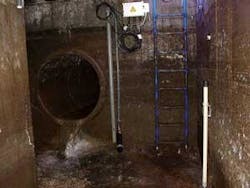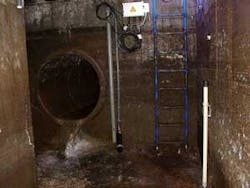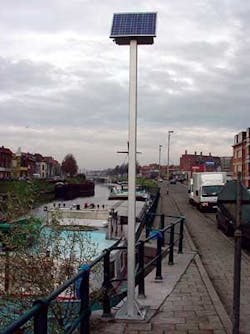No Flooding in Flanders
By Angus Fosten
Overflow monitoring stations in Belgian sewerage network from Partech Instrument, Swedmeter AB and C.R.A. nv give advanced notice of trouble spots to avoid problems.
To overcome the problem of sewerage overflows throughout Belgium, some 300 monitoring stations have been installed using sensors developed by Partech Instruments for measuring water flows and water quality.
At the end of the 1980s, Belgium was acknowledged to be well behind of neighbouring countries with regard to wastewater treatment. During the following decade, an intensive programme of investment was undertaken, particularly at the regional level. By the end of 2002, about 60% of all Flemish households had been connected up to a sewer water treatment installation. With further investment, this figure reached about 90% by the end 2004. In addition, the imposition of levies and licenses also encouraged many industrial companies to step up their efforts in terms of improving wastewater and effluent treatment.
As a result of this intensive infrastructure investment, there has been a remarkable improvement in the quality of surface water in Flanders. In former days, there were an alarming number of watercourses that contained little or no biological life at all. Today, over 55% are only moderately polluted and upward of 13% are qualified either as “acceptable” or “not polluted”. All this has had a positive effect on the country’s ecosystem, which now contains a greater volume and a more varied selection of aquatic life.
Still, improvements reported earlier this decade haven’t necessarily maintained momentum in spite of ongoing treatment efforts. One cause shown to be an obstruction to further improvement is the ineffectiveness of managing sewerage overflows. To gain a clearer picture of this problem, the Flemish Environment Society (VMM) has invested in a monitoring project using field measuring installations on overflows throughout its operating territory.
In common with the UK, the Belgian sewer schemes are generally of the mixed type, in that both effluent and rain water are removed jointly to the treatment installation. In spite of the fact that the sewer scheme is designed to transport a volume equal to six times the average flow at dry weather conditions, some points in the scheme all too frequently come under pressure. To prevent surplus water from flooding the streets, the flow is directed by means of an overflow construction directly and untreated into the watercourse.
In theory, it’s estimated that about 4,000 overflow constructions in Flanders only become effective during 2% of the time, which represents seven full days a year. In reality, some overflow constructions seldom or ever become effective and others are only active when it rains. Besides rain, there are also other factors, such as faulty pump installations, groundwater leaking through cracks in sewerage pipes, watercourses connected to the sewer scheme, etc., that can have a positive or negative role in an actual overflow event.
As it’s very difficult to predict an overflow event and given the fact the event itself is limited in duration, it was necessary to instigate an ongoing measurement campaign over several years. Additionally, there was the problem that the overflow constructions are often in rural areas far from power and communication supplies, or in urban locations where space is at a premium and vandalism is an issue.
The solution developed by Swedmeter AB and Partech and supplied by C.R.A. nv uses over 300 solar-powered monitoring stations which employ loggers that can store data locally and transmit data by means of wireless communication to a central database. The Swedmeter logger and data communication package is located with the solar power system aboveground, whilst Partech’s WaterWatch sondes are underground. In this case, the sondes monitor conductivity and suspended solids. Alternative sondes can add pH, redox, dissolved oxygen and water level.
The sonde is a compact fixed site unit that can contain up to five separate sensors. Contained in a water tight, rugged housing, featuring a self-cleaning facility to reduce maintenance, it provides the ability to measure a wide range of parameters simultaneously. Most importantly for remote locations, the instrument has been optimized to require a very low level of power.
Besides giving an indication of the duration of the overflow, each monitoring station also provides an estimation of the actual flow and degree of pollution of the drained water. Analysis of collected data enables VMM to establish a clear picture of these problems and develop appropriate solutions to overcome the problems it faces.
In the city of Leuven, a model based on the sewer system was developed by wastewater treatment company Aquafin that allows introduction of additional parameters, such as the effect of local rainfall by simulating behaviour of the sewer scheme. In order to feed the model with real local precipitation data rain gauges are required and certain measuring stations were equipped with rain gauges financed by the city of Leuven.
Collected data is transmitted to VMM which feeds it into the model, and then returns the output to the city’s technical department. This is an example of an added capability that can easily be implemented in the monitoring network and which offers a unique opportunity for VMM, Aquafin and the city of Leuven to share resources and data.
For Partech Instruments, the size and scope of the application is a major confirmation of the capability and reliability of its WaterWatch technology. With some 300 sites now being kitted out, Partech has a sizeable installed base offering considerable potential for demonstrating the performance of its products. The idea has already been picked up in Spain where a number of similar packages are currently being trialed.
WWi
Author’s note:
Angus Fosten is sales and marketing director for Partech Instruments, based in Charleston, St. Austell, Cornwall. Partech is a specialist company providing analysers and instruments for monitoring and control in wastewater, drinking water, industrial effluent and surface water applications. Contact: +44(0)1726 879800, [email protected] or www.partech.co.uk



